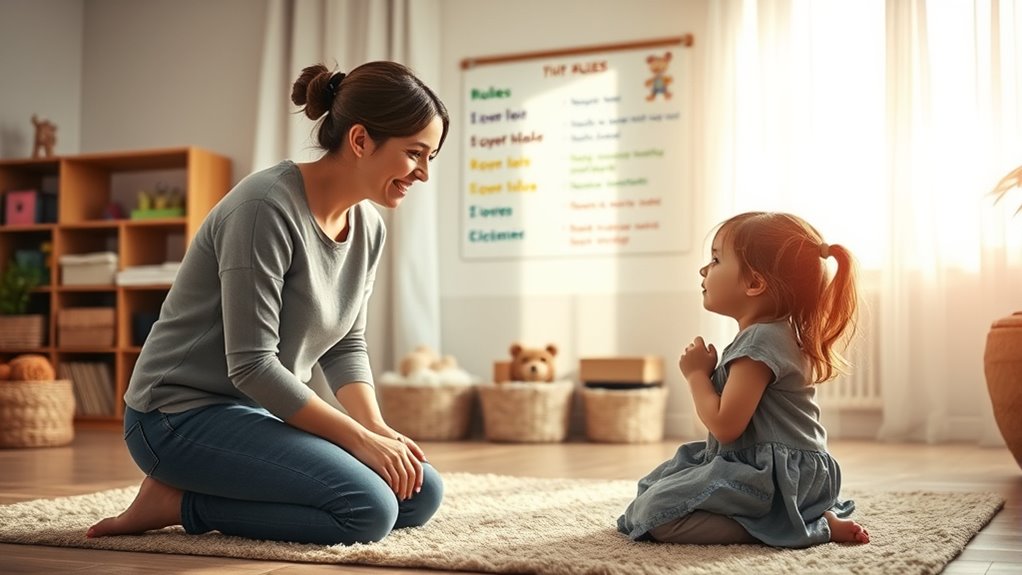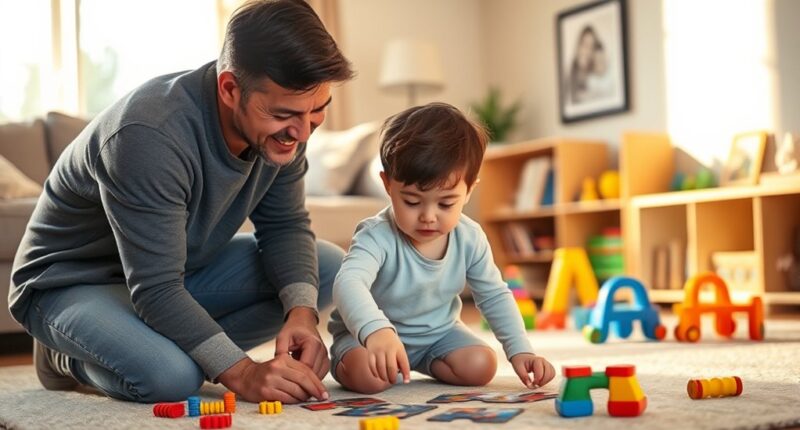Positive parenting techniques focus on creating a nurturing environment for children. You can establish clear rules to help your child understand expected behaviors while using calm communication instead of yelling. It’s essential to validate their feelings and encourage open dialogue. This approach promotes emotional intelligence and cooperation, helping develop skills like empathy and effective communication. By setting consistent boundaries, you’ll guide your child toward better behavior and emotional growth. There’s much more to explore about these impactful methods.
Key Takeaways
- Establish clear rules and expectations to provide children with a sense of safety and predictability in their behavior.
- Use positive reinforcement techniques to encourage and reward good behavior, promoting its repetition.
- Communicate calmly and validate children’s feelings to foster emotional development and effective problem-solving.
- Implement logical consequences that teach valuable lessons, balancing discipline with understanding and empathy.
- Encourage open communication to allow children to express their thoughts and feelings, enhancing their emotional intelligence.
Understanding Positive Discipline

When you embrace positive discipline, you’re not just focusing on correcting misbehavior; you’re fostering an environment where children learn and grow. This model emphasizes teaching good behavior while minimizing harmful actions, contrasting sharply with negative discipline.
By prioritizing mutual respect and understanding the reasons behind behaviors, you create a strong foundation for effective communication. Your goal is to instill a sense of connection and belonging in your children, promoting long-term changes rather than quick fixes.
Prioritizing respect and understanding fosters effective communication, nurturing connection and long-lasting change in children.
Through kindness and firmness, you can set clear boundaries while encouraging problem-solving skills. This approach empowers children to recognize their capabilities, ultimately leading to improved self-esteem and stronger relationships.
Positive discipline nurtures a supportive environment where everyone thrives.
Key Techniques for Effective Behavior Management

Effective behavior management is essential for fostering a positive parent-child relationship, as it sets the stage for learning and growth. Start by setting clear rules that help your child understand expected behaviors. Consistently enforce these rules to teach respect for authority.
Focus on positive reinforcement; praising good behavior encourages its repetition. Avoid yelling, as calm communication works better in resolving issues. Validate your child’s feelings to support their emotional development.
When negative behavior arises, use the “Stop, Redirect, Reinforce” technique to redirect their attention to a positive activity. Engage in enjoyable tasks together to promote positive interactions, and teach social skills to enhance communication.
These techniques create a supportive environment for your child to thrive.
The Role of Emotional Intelligence in Discipline

Emotional intelligence plays a critical role in discipline, shaping how you guide your child’s behavior and responses. It starts early, influenced by your bond with your child, and helps you manage your emotions during conflicts.
Instead of resorting to punitive methods, which can promote avoidance, you can foster cooperation through understanding and empathy. By modeling effective emotional regulation, you teach your child to identify, express, and manage their feelings.
This authoritative approach, marked by warmth and authority, enhances your child’s self-esteem and emotional autonomy. Ultimately, nurturing emotional intelligence creates a supportive family environment that encourages open communication and trust, laying the foundation for successful conflict resolution and positive behavior management.
Setting Boundaries and Expectations

Setting boundaries and expectations is essential for fostering a nurturing environment where children can thrive. Clear communication helps your child understand what’s expected, providing safety and predictability. Incorporating consistent discipline strategies can further enhance a child’s understanding of boundaries.
Consistency in enforcing these boundaries reinforces that rules are non-negotiable. Guarantee you set realistic limits that are developmentally appropriate, avoiding overly strict rules that might lead to frustration.
Encourage open communication, allowing your child to express thoughts and feelings while validating their emotions. Model the respectful behavior you want to see in them, demonstrating self-discipline and empathy.
Balance discipline with understanding, using logical consequences to teach rather than punish. By doing so, you create a supportive environment where your child feels secure and learns valuable life lessons. Additionally, fostering open communication can strengthen your relationship and provide a foundation for discussing important topics in the future.
Long-Term Benefits of Positive Parenting Approaches

While many parenting styles focus on immediate discipline, positive parenting approaches yield significant long-term benefits that shape children’s futures.
You’ll notice improved mental health outcomes in your kids, reducing their risk of depression and anxiety. They’ll develop emotional resilience, higher self-esteem, and stronger relationships, all of which contribute to their overall well-being.
Socially and emotionally, your children will gain essential skills like effective communication and empathy, making them more compassionate individuals.
Academically, they’ll thrive, showing better school adjustment and cognitive development.
This nurturing approach enhances family dynamics, fostering trust and open communication.
Ultimately, positive parenting not only prepares children for success but also promotes healthier lifestyles and community involvement, benefiting society as a whole.
Frequently Asked Questions
How Do I Handle Tantrums Using Positive Discipline Techniques?
When you handle tantrums, stay calm and acknowledge your child’s feelings.
Offer limited choices to give them a sense of control and use distraction techniques to shift their focus.
Maintain consistency in your responses to create a predictable environment.
Establish clear boundaries and reinforce positive behaviors with praise.
What Are Common Mistakes in Positive Parenting Discipline?
You might think that positive parenting is a foolproof art, but it’s riddled with common mistakes!
If you’re inconsistent with rules, your child’s bound to feel confused. Mixed messages from different parenting styles can create chaos, while neglecting to recognize positive behavior might just invite more mischief.
Focusing solely on punishment instead of teaching can stifle motivation.
How Can I Involve My Partner in Positive Discipline?
To involve your partner in positive discipline, start by discussing your upbringing and how it shapes your views.
Engage in respectful, non-interruptive dialogues to share perspectives. Identify any concerns about each other’s methods and agree on shared rules and consequences.
Regularly review your strategies together, adjusting them as needed. This collaborative approach fosters teamwork, guarantees consistency for your child, and strengthens your partnership in parenting.
Are There Age-Specific Techniques for Positive Discipline?
Sure, you could just throw your hands up and hope your child figures it out alone, but age-specific techniques for positive discipline are way more effective.
For toddlers, distraction works wonders, while preschoolers thrive on limited choices. As kids age, involving them in problem-solving nurtures responsibility.
You’ll find that clear communication and consistent rules create an environment where your child understands expectations, leading to smoother interactions and fewer conflicts.
How Can I Measure My Child’s Emotional Growth?
To measure your child’s emotional growth, use tools like the Early Emotion Regulation Behavior Questionnaire or the Social-Emotional Assessment/Evaluation Measure.
These assessments help you understand their emotion regulation and social-emotional development.
Additionally, observe their daily interactions and behaviors, noting how they express and manage emotions.
Engaging in conversations about feelings and validating their emotions can also provide insights into their emotional maturity and growth over time.
Conclusion
In embracing positive parenting techniques, you’re not just managing behavior; you’re nurturing a foundation of respect and understanding. By fostering emotional intelligence and setting clear boundaries, you’re guiding your child toward a brighter future. The long-term benefits of these approaches enrich both your relationship and your child’s development. Remember, every moment spent cultivating these skills is a step toward a harmonious household, where discipline transforms into a gentle art of guidance rather than mere correction.









